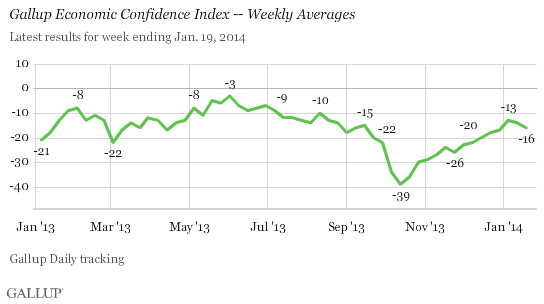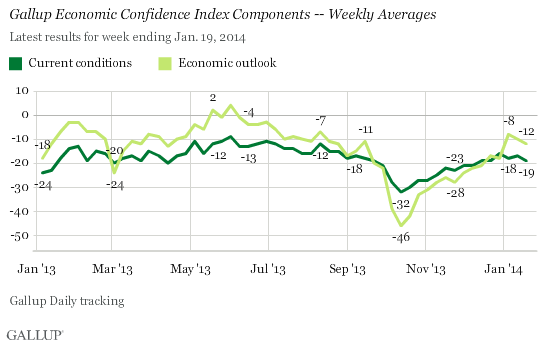WASHINGTON, D.C. -- Americans' confidence in the economy slipped during the past two weeks, ending the gradual rise that coincided with the end of the federal government shutdown in mid-October. Gallup's Economic Confidence Index averaged -16 last week, down slightly from -13 in the first week of 2014.

The recent dip in Americans' economic confidence is likely related to the federal government reporting the weakest job growth in three years for the month of December and a declining unemployment rate, which possibly signals that disgruntled job seekers are dropping out of the labor force. The Economic Confidence Index has now settled between the -10 found in Gallup's three-day rolling averages recorded before the jobs report and the -18 measured immediately after.
Americans' Outlook Sours More Than Their Perceptions of Current Conditions
Americans' assessments of current economic conditions and their perceptions of the economy's direction -- the two components that make up the index -- both declined two points last week. But Americans' economic outlook has fallen more than their evaluation of current conditions over the past two weeks.
Americans' net economic outlook score was -12 last week, down four points from the -8 found in the first week of 2014. The current score represents 42% who said the economy is getting better and 54% who said it is getting worse.
Last week's net current conditions score was -19, similar to the -18 found in the first week of January. The current score represents 17% of Americans who say the economy is "excellent" or "good," while 36% say it is "poor."

Bottom Line
Americans' rising confidence in the economy hit a slight snag over the last two weeks, likely because of the negative Bureau of Labor Statistics jobs report. Gallup's three-day rolling averages indicate that confidence improved toward the end of last week, suggesting that the dip in economic confidence may be temporary.
Americans will likely need to see consistent improvement in economic measures and noticeable increases in their paychecks before feeling significantly more positive about the economy.
Gallup.com reports results from these indexes in daily, weekly, and monthly averages and in Gallup.com stories. Complete trend data are always available to view and export in the following charts:
Daily: Employment, Economic Confidence and Job Creation, Consumer Spending
Weekly: Employment, Economic Confidence, Job Creation, Consumer Spending
Read more about Gallup's economic measures.
View our economic release schedule.
Survey Methods
Results for this Gallup poll are based on telephone interviews conducted Jan. 13-19, 2014, on the Gallup Daily tracking survey, with a random sample of 3,551 adults, aged 18 and older, living in all 50 U.S. states and the District of Columbia.
For results based on the total sample of national adults, the margin of sampling error is ±3 percentage points at the 95% confidence level.
Interviews are conducted with respondents on landline telephones and cellular phones, with interviews conducted in Spanish for respondents who are primarily Spanish-speaking. Each sample of national adults includes a minimum quota of 50% cellphone respondents and 50% landline respondents, with additional minimum quotas by time zone within region. Landline and cellular telephone numbers are selected using random-digit-dial methods. Landline respondents are chosen at random within each household on the basis of which member had the most recent birthday.
Samples are weighted to correct for unequal selection probability, nonresponse, and double coverage of landline and cell users in the two sampling frames. They are also weighted to match the national demographics of gender, age, race, Hispanic ethnicity, education, region, population density, and phone status (cellphone only/landline only/both, cellphone mostly, and having an unlisted landline number). Demographic weighting targets are based on the most recent Current Population Survey figures for the aged 18 and older U.S. population. Phone status targets are based on the most recent National Health Interview Survey. Population density targets are based on the most recent U.S. census. All reported margins of sampling error include the computed design effects for weighting.
In addition to sampling error, question wording and practical difficulties in conducting surveys can introduce error or bias into the findings of public opinion polls.
For more details on Gallup's polling methodology, visit www.gallup.com.
